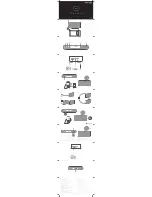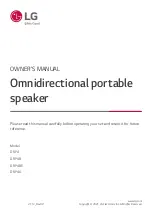
2
500Wi OM
Quick Start Guide
Use outdoors only. Generators produce carbon monoxide
— a poisonous, colorless,
odorless gas that can cause death or serious injury.
Always operate on a level surface.
Keep away from rain, snow or other wet conditions.
Keep away from smoking materials, sparks, and other sources of combustion when
refueling.
Pre-Operation
1.
Add oil by removing the maintenance panel and inspecting the dipstick. Fill the oil reservoir with 15.6 oz.
(460 ml) of oil or to the full mark on the dipstick. Use appropriate grade, high-detergent, premium quality,
4-stroke engine oil (synthetic or conventional). Use SAE 15W-40 viscosity oil unless operating at ambient
temperatures below 32° F (0° C). For temperatures below 32° F, use SAE 0W-40 viscosity oil. Refer to the
Operating at extreme temperatures
section for more information.
2.
Carefully add regular unleaded automotive gasoline up to the shoulder of the filler neck. To avoid spilling
fuel, use care to not fill too quickly or over fill. Avoid getting dirt, dust, or water in the fuel tank. Do not use a
blend that contains more than 10% ethanol. Do not use gasoline containing methanol. An octane rating of
87 or higher is recommended
.
Do not add 2-Stroke oil to your fuel. Doing so will void your warranty.
It is recommended that you use a fuel stabilizer, such as STA-BIL®, to help prevent fuel
oxidation (breakdown) and the formation of gum and varnish, and to inhibit corrosion in
the fuel system and carburetor.
Operation
1.
Ensure that no loads have been connected to the AC receptacles.
2.
Open the fuel valve. If the fuel tank was empty, it may also be necessary to pump the primer bulb 15 to 20
times to get fuel to the carburetor.
3.
Push the engine switch on the control panel to the “ON” position.
4.
Move the choke leve
r to the “START” position.
5.
Pull the starter grip lightly until resistance is felt, then pull briskly out. Repeat until the engine starts.
6.
Move the choke lever to the “RUN” position after the engine warms up.
7.
The green “RUN” light will illuminate when the generator is ready for use. Before connecting any loads,
ground the generator with a length of heavy cable, connecting the generator’s grounding terminal to an
external ground source.
8.
Make sure that all appliances to be connected have been switched off and are in good working order.
Confirm that the combined electrical rating of the appliances does not exceed that of the generator.
9.
Connect the appliance to the appropriate receptacle on the generator’s control panel.
10.
To minimize fuel consumption and noise,
push the economy switch to the “ON” position. This setting
regulates the engine’s speed so that it matches the needs of the connected loads. Do not use the economy
setting if you are connecting items with electric motors that have a high amperage draw during startup or
with appliances that cycle on and off rapidly.
Shutdown
In
an emergency, pushing the Engine Switch on the control panel to the “OFF” position
will automatically stop the engine with or without a load. However, repeatedly stopping
the generator without disconnecting all loads can cause damage to the generator or
appliances.
1.
Turn off all connected appliances and disconnect from the generator.
2.
Push the engine switch on the control panel to the “OFF” position.
3.
Turn the fuel valve off.



































